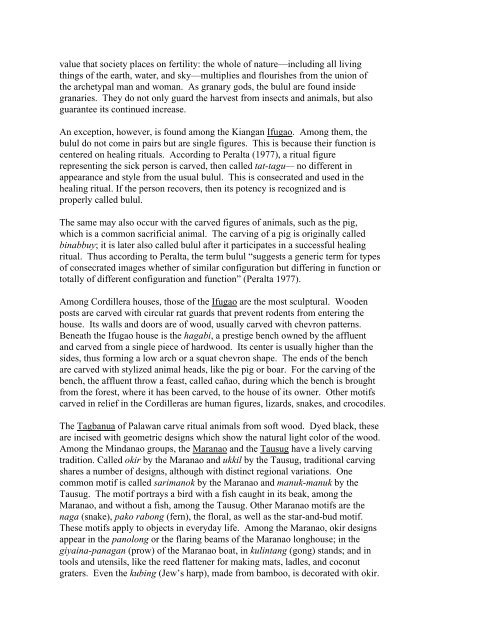SCULPTURE Sculpture is the art of making three-dimensional ...
SCULPTURE Sculpture is the art of making three-dimensional ...
SCULPTURE Sculpture is the art of making three-dimensional ...
You also want an ePaper? Increase the reach of your titles
YUMPU automatically turns print PDFs into web optimized ePapers that Google loves.
value that society places on fertility: <strong>the</strong> whole <strong>of</strong> nature—including all living<br />
things <strong>of</strong> <strong>the</strong> e<strong>art</strong>h, water, and sky—multiplies and flour<strong>is</strong>hes from <strong>the</strong> union <strong>of</strong><br />
<strong>the</strong> archetypal man and woman. As granary gods, <strong>the</strong> bulul are found inside<br />
granaries. They do not only guard <strong>the</strong> harvest from insects and animals, but also<br />
guarantee its continued increase.<br />
An exception, however, <strong>is</strong> found among <strong>the</strong> Kiangan Ifugao. Among <strong>the</strong>m, <strong>the</strong><br />
bulul do not come in pairs but are single figures. Th<strong>is</strong> <strong>is</strong> because <strong>the</strong>ir function <strong>is</strong><br />
centered on healing rituals. According to Peralta (1977), a ritual figure<br />
representing <strong>the</strong> sick person <strong>is</strong> carved, <strong>the</strong>n called tat-tagu— no different in<br />
appearance and style from <strong>the</strong> usual bulul. Th<strong>is</strong> <strong>is</strong> consecrated and used in <strong>the</strong><br />
healing ritual. If <strong>the</strong> person recovers, <strong>the</strong>n its potency <strong>is</strong> recognized and <strong>is</strong><br />
properly called bulul.<br />
The same may also occur with <strong>the</strong> carved figures <strong>of</strong> animals, such as <strong>the</strong> pig,<br />
which <strong>is</strong> a common sacrificial animal. The carving <strong>of</strong> a pig <strong>is</strong> originally called<br />
binabbuy; it <strong>is</strong> later also called bulul after it p<strong>art</strong>icipates in a successful healing<br />
ritual. Thus according to Peralta, <strong>the</strong> term bulul “suggests a generic term for types<br />
<strong>of</strong> consecrated images whe<strong>the</strong>r <strong>of</strong> similar configuration but differing in function or<br />
totally <strong>of</strong> different configuration and function” (Peralta 1977).<br />
Among Cordillera houses, those <strong>of</strong> <strong>the</strong> Ifugao are <strong>the</strong> most sculptural. Wooden<br />
posts are carved with circular rat guards that prevent rodents from entering <strong>the</strong><br />
house. Its walls and doors are <strong>of</strong> wood, usually carved with chevron patterns.<br />
Beneath <strong>the</strong> Ifugao house <strong>is</strong> <strong>the</strong> hagabi, a prestige bench owned by <strong>the</strong> affluent<br />
and carved from a single piece <strong>of</strong> hardwood. Its center <strong>is</strong> usually higher than <strong>the</strong><br />
sides, thus forming a low arch or a squat chevron shape. The ends <strong>of</strong> <strong>the</strong> bench<br />
are carved with stylized animal heads, like <strong>the</strong> pig or boar. For <strong>the</strong> carving <strong>of</strong> <strong>the</strong><br />
bench, <strong>the</strong> affluent throw a feast, called cañao, during which <strong>the</strong> bench <strong>is</strong> brought<br />
from <strong>the</strong> forest, where it has been carved, to <strong>the</strong> house <strong>of</strong> its owner. O<strong>the</strong>r motifs<br />
carved in relief in <strong>the</strong> Cordilleras are human figures, lizards, snakes, and crocodiles.<br />
The Tagbanua <strong>of</strong> Palawan carve ritual animals from s<strong>of</strong>t wood. Dyed black, <strong>the</strong>se<br />
are inc<strong>is</strong>ed with geometric designs which show <strong>the</strong> natural light color <strong>of</strong> <strong>the</strong> wood.<br />
Among <strong>the</strong> Mindanao groups, <strong>the</strong> Maranao and <strong>the</strong> Tausug have a lively carving<br />
tradition. Called okir by <strong>the</strong> Maranao and ukkil by <strong>the</strong> Tausug, traditional carving<br />
shares a number <strong>of</strong> designs, although with d<strong>is</strong>tinct regional variations. One<br />
common motif <strong>is</strong> called sarimanok by <strong>the</strong> Maranao and manuk-manuk by <strong>the</strong><br />
Tausug. The motif portrays a bird with a f<strong>is</strong>h caught in its beak, among <strong>the</strong><br />
Maranao, and without a f<strong>is</strong>h, among <strong>the</strong> Tausug. O<strong>the</strong>r Maranao motifs are <strong>the</strong><br />
naga (snake), pako rabong (fern), <strong>the</strong> floral, as well as <strong>the</strong> star-and-bud motif.<br />
These motifs apply to objects in everyday life. Among <strong>the</strong> Maranao, okir designs<br />
appear in <strong>the</strong> panolong or <strong>the</strong> flaring beams <strong>of</strong> <strong>the</strong> Maranao longhouse; in <strong>the</strong><br />
giyaina-panagan (prow) <strong>of</strong> <strong>the</strong> Maranao boat, in kulintang (gong) stands; and in<br />
tools and utensils, like <strong>the</strong> reed flattener for <strong>making</strong> mats, ladles, and coconut<br />
graters. Even <strong>the</strong> kubing (Jew’s harp), made from bamboo, <strong>is</strong> decorated with okir.

















